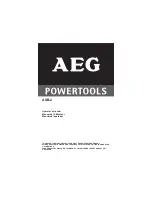
16
| English
2 609 141 290 | (16.6.15)
Bosch Power Tools
Switching On and Off
To
start
the machine, press the On/Off switch
10
and keep it
pressed.
To
switch off
the machine, release the On/Off switch
10
.
To save energy, only switch the power tool on when using it.
Adjusting the Speed
The speed of the switched-on power tool can be variably ad-
justed, depending on how far the On/Off switch
10
is
pressed.
Light pressure on the On/Off switch
10
results in a low rota-
tional speed. Further pressure on the switch results in an in-
crease in speed.
Preselecting the Speed/Impact Rate
With the button
6
you can preselect the required speed/im-
pact rate in 2 stages. Press the button
6
repeatedly until the
desired setting appears in the speed indicator
5
. The selected
setting will be saved.
The required speed/impact rate depends on the material and
the working conditions, and can be determined through prac-
tical testing.
Switching the “PowerLight” On/Off
To switch the “PowerLight”
3
on
, press button
4
. To switch
the “PowerLight”
3
off
, press button
4
again.
Battery Charge-control Indication
The battery charge-control indicator
11
consists of three
green LEDs, and indicates the charge condition of the battery
for a few seconds when the On/Off switch
10
is pressed half-
way or fully.
Temperature Dependent Overload Protection
In normal conditions of use, the power tool cannot be over-
loaded. If the power tool is overloaded or not kept within the
permitted battery temperature range, the power output is re-
duced or the power tool is switched off. The power tool will
not run at full power output again until the permitted battery
temperature has been reached.
Working Advice
Apply the power tool to the screw/nut only when it is
switched off.
Rotating tool inserts can slip off.
The torque depends on the impact duration. The maximum
achieved torque results from the sum of all individual torques
achieved through impact. The maximum torque is achieved
after an impact duration of 6–10 seconds. After this dura-
tion, the tightening torque is increased only minimally.
The impact duration is to be determined for each required
tightening torque. The actually achieved tightening torque is
always to be checked with a torque wrench.
Screw Applications with Hard, Spring-loaded or Soft Seat
A test in which the achieved torques in an impact series are
measured and transferred to a diagram will produce the curve
of a torque characteristic. The height of the curve corre-
sponds with the maximum reachable torque, and the steep-
ness indicates the duration in which this is achieved.
A torque gradient depends on the following factors:
– Strength properties of the screws/nuts
– Type of backing (washer, disc spring, seal)
– Strength properties of the material being screwed/bolted
together
– Lubrication conditions at the screw/bolt connection
The following application cases result accordingly:
– A
hard seat
is given for metal-to-metal screw applications
with the use of washers. After a relatively short impact du-
ration, the maximum torque is reached (steep characteris-
tic curve). Unnecessary long impact duration only causes
damage to the machine.
– A
spring-loaded seat
is given for metal-to-metal screw ap-
plications, however with the use of spring washers, disc
springs, studs or screws/nuts with conical seat as well as
when using extensions.
– A
soft seat
is given for screw applications, e. g., metal on
wood or when using lead washers or fibre washers as back-
ing.
For a spring-loaded seat as well as for a soft seat, the maxi-
mum tightening torque is lower than for a hard seat. Also, a
clearly longer impact duration is required.
Reference Values for Maximum Screw/Bolt Tightening Torques
Calculated from the tensional cross-section; utilization of the yield point 90 % (with friction coefficient μ
total
= 0.12). As a control
measure, always check the tightening torque with a torque wrench.
LED
Capacity
Continuous lighting 3 x green
≥ 2/3
Continuous lighting 2 x green
≥ 1/3
Continuous lighting 1 x green
< 1/3
Flashing light 1 x green
Reserve
Property Classes accord-
ing to DIN 267
Standard Screws/Bolts
High-strength Bolts
3.6
4.6
5.6
4.8
6.6
5.8
6.8
6.9
8.8
10.9
12.9
M 6
2.71
3.61
4.52
4.8
5.42
6.02
7.22
8.13
9.7
13.6
16.2
M 8
6.57
8.7
11
11.6
13.1
14.6
17.5
19.7
23
33
39
M 10
13
17.5
22
23
26
29
35
39
47
65
78
M 12
22.6
30
37.6
40
45
50
60
67
80
113
135
M 14
36
48
60
65
72
79
95
107
130
180
215
M 16
55
73
92
98
110
122
147
165
196
275
330
OBJ_BUCH-2221-002.book Page 16 Tuesday, June 16, 2015 9:46 AM
















































